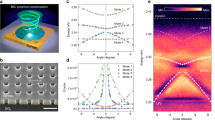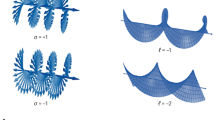Abstract
The idea of temporal solitons in optical fibres as a means to compensate for the chromatic dispersion-induced temporal broadening of pulses via the intensity-dependent refractive index of silica (the Kerr effect) was introduced by Hasegawa and Tappert in a paper that was submitted on 12 April 1973. In this Perspective we present a brief historical overview of how this prediction developed in light of other technological developments made through the decades, followed by an extensive forward-looking discussion on the most exciting opportunities in soliton research.
This is a preview of subscription content, access via your institution
Access options
Access Nature and 54 other Nature Portfolio journals
Get Nature+, our best-value online-access subscription
$29.99 / 30 days
cancel any time
Subscribe to this journal
Receive 12 print issues and online access
$209.00 per year
only $17.42 per issue
Buy this article
- Purchase on Springer Link
- Instant access to full article PDF
Prices may be subject to local taxes which are calculated during checkout

Similar content being viewed by others
References
Hasegawa, A. & Tappert, F. Transmission of stationary nonlinear optical pulses in dispersive dielectric fibers. I. Anomalous dispersion. Appl. Phys. Lett. 23, 142–144 (1973).
Zakharov, V. E. & Shabat, A. B. Exact theory of two-dimensional self-focusing and one-dimensional self-modulation of waves in nonlinear media. J. Exp. Theor. Phys. 34, 62–69 (1972).
Hasegawa, A. Optical soliton: a memoir of its discovery and future prospects. Opt. Commun. 532, 129222 (2023).
Dudley, J. M., Finot, C., Genty, G. & Taylor, R. Fifty years of fiber solitons. Opt. Photon. News 34, 28–33 (2023).
Agrawal, G. P. Nonlinear Fiber Optics 6th edn (Academic, 2019).
Mollenauer, L. F., Stolen, R. H. & Gordon, J. P. Experimental observation of picosecond pulse narrowing and solitons in optical fibers. Phys. Rev. Lett. 45, 1095–1098 (1980).
Mollenauer, L. F., Stolen, R. H., Gordon, J. P. & Tomlinson, W. J. Extreme picosecond pulse narrowing by means of soliton effect in single-mode optical fibers. Opt. Lett. 8, 289–291 (1983).
Taylor, J. R. Early optical soliton research at Imperial College London. Opt. Commun. 536, 129382 (2023).
Kodama, Y. & Hasegawa, A. Guiding-center soliton in optical fibers. Opt. Lett. 15, 1443–1445 (1990).
Gordon, J. P. & Haus, H. A. Random walk of coherently amplified solitons in optical fiber transmission. Opt. Lett. 11, 665–667 (1986).
Suzuki, M. et al. Reduction of Gordon–Haus timing jitter by periodic dispersion compensation in soliton transmission. Electron. Lett. 31, 2027–2029 (1995).
Smith, N. J., Knox, F. M., Doran, N. J., Blow, K. J. & Bennion, I. Enhanced power solitons in optical fibres with periodic dispersion management. Electron. Lett. 32, 54–55 (1996).
Gabitov, I. & Turitsyn, S. K. Averaged pulse dynamics in a cascaded transmission system with passive dispersion compensation. Opt. Lett. 21, 327–329 (1996).
Mollenauer, L. F. & Mamyshev, P. V. Massive wavelength-division multiplexing with solitons. IEEE J. Quantum Electron. 34, 2089–2102 (1998).
Pratt, A. R. et al. 5,745 km DWDM transcontinental field trial using 10 Gbit/s dispersion managed solitons and dynamic gain equalization. In Optical Fiber Communications Conference PD26-P1 (Optica Publishing Group, 2003).
Gnauck, A. H. et al. 2.5 Tb/s (64 × 42.7 Gb/s) transmission over 40 × 100 km NZDSF using RZ-DPSK format and all-Raman-amplified spans. In Optical Fiber Communication Conference and Exhibit FC2-FC2 (IEEE, 2002).
Hasegawa, A. Soliton-based optical communications: an overview. IEEE J. Sel. Top. Quantum Electron. 6, 1161–1172 (2000).
Dudley, J. M., Genty, G. & Coen, S. Supercontinuum generation in photonic crystal fiber. Rev. Mod. Phys. 78, 1135–1184 (2006).
Herr, T. et al. Temporal solitons in optical microresonators. Nat. Photon. 8, 145–152 (2014).
Tamura, K., Ippen, E. P., Haus, H. A. & Nelson, L. E. 77-fs pulse generation from a stretched-pulse mode-locked all-fiber ring laser. Opt. Lett. 18, 1080–1082 (1993).
Rozanov, N. N. Dissipative optical solitons. Phys. Usp. 43, 421–424 (2000).
Akhmediev, N. & Ankiewicz, A. in Dissipative Solitons Vol. 661 (eds Akhmediev, N. & Ankiewicz, A.) 1–17 (Springer, 2005).
Mollenauer, L. F. & Stolen, R. H. The soliton laser. Opt. Lett. 9, 13–15 (1984).
Grelu, P. & Akhmediev, N. Dissipative solitons for mode-locked lasers. Nat. Photon. 6, 84–92 (2012).
Wise, F. W., Chong, A. & Renninger, W. H. High-energy femtosecond fiber lasers based on pulse propagation at normal dispersion. Laser Photon. Rev. 2, 58–73 (2008).
Blanco-Redondo, A. et al. Pure-quartic solitons. Nat. Commun. 7, 10427 (2016).
Runge, A. F. J. et al. Infinite hierarchy of solitons: interaction of Kerr nonlinearity with even orders of dispersion. Phys. Rev. Res. 3, 013166 (2021).
Runge, A. F. J. et al. The pure-quartic soliton laser. Nat. Photon. 14, 492–497 (2020).
Van Howe, J. et al. Soliton self-frequency shift below 1300 nm in higher-order-mode, solid silica-based fiber. Opt. Lett. 32, 340–342 (2007).
Horton, N. G. et al. In vivo three-photon microscopy of subcortical structures of an intact mouse brain. Nat. Photon. 7, 205–209 (2013).
Ouzounov, D. G. et al. Generation of megawatt optical solitons in hollow-core photonic band-gap fibers. Science 301, 1702–1704 (2003).
Chen, Y.-H., Sidorenko, P., Antonio-Lopez, E., Amezcua-Correa, R. & Wise, F. W. Efficient soliton self-frequency shift in hydrogen-filled hollow-core fiber. Opt. Lett. 47, 285–288 (2022).
Travers, J. C., Grigorova, T. F., Brahms, C. & Belli, F. High-energy pulse self-compression and ultraviolet generation through soliton dynamics in hollow capillary fibres. Nat. Photon. 13, 547–554 (2019).
Hasegawa, A. Self-confinement of multimode optical pulse in a glass fiber. Opt. Lett. 5, 416–417 (1980).
Renninger, W. H. & Wise, F. W. Optical solitons in graded-index multimode fibres. Nat. Commun. 4, 1719 (2013).
Wright, L. G., Christodoulides, D. N. & Wise, F. W. Spatiotemporal mode-locking in multimode fiber lasers. Science 358, 94–97 (2017).
Petersen, C. R. et al. Mid-infrared supercontinuum covering the 1.4–13.3 μm molecular fingerprint region using ultra-high NA chalcogenide step-index fibre. Nat. Photon. 8, 830–834 (2014).
Genty, G. et al. Machine learning and applications in ultrafast photonics. Nat. Photon. 15, 91–101 (2021).
Kippenberg, T. J., Gaeta, A. L., Lipson, M. & Gorodetsky, M. L. Dissipative Kerr solitons in Kerr microresonators. Science 361, eaan8083 (2018).
Cole, D. C., Lamb, E., Del’Haye, P., Diddams, S. A. & Papp, S. B. Soliton crystals in Kerr resonators. Nat. Photon. 11, 671–677 (2017).
Rowley, M. et al. Self-emergence of robust solitons in a microcavity. Nature 608, 303–309 (2022).
Smirnov, S., Sturman, B., Podivilov, E. & Breunig, I. Walk-off controlled self-starting frequency combs in χ(2) optical microresonators. Opt. Express 28, 18006–18017 (2020).
Taheri, H. & Matsko, A. B. Quartic dissipative solitons in optical Kerr cavities. Opt. Lett. 44, 3086–3089 (2019).
Blanco-Redondo, A., Dorche, A. E. & Stern, B. Dual-ring resonators for optical frequency comb generation. US patent 11,402,724 (2022).
Yao, S., Liu, K. & Yang, C. Pure quartic solitons in dispersion-engineered aluminum nitride micro-cavities. Opt. Express 29, 8312–8322 (2021).
Lee, J. H., van Howe, J., Xu, C. & Liu, X. Soliton self-frequency shift: experimental demonstrations and applications. IEEE J. Sel. Top. Quantum Electron. 14, 713–723 (2008).
Xu, C. & Wise, F. W. Recent advances in fibre lasers for nonlinear microscopy. Nat. Photon. 7, 875–882 (2013).
Hasegawa, A. & Nyu, T. Eigenvalue communication. J. Lightwave Technol. 11, 395–399 (1993).
Turitsyn, S. K. et al. Nonlinear Fourier transform for optical data processing and transmission: advances and perspectives. Optica 4, 307–322 (2017).
Pang, M. et al. All-optical bit storage in a fibre laser by optomechanically bound states of solitons. Nat. Photon. 10, 454–458 (2016).
Wabnitz, S. Suppression of interactions in a phase-locked soliton optical memory. Opt. Lett. 18, 601–603 (1993).
Marcucci, G., Pierangeli, D. & Conti, C. Theory of neuromorphic computing by waves: machine learning by rogue waves, dispersive shocks, and solitons. Phys. Rev. Lett. 125, 093901 (2019).
Malomed, B. A. Bound solitons in the nonlinear Schrödinger–Ginzburg–Landau equation. Phys. Rev. A 44, 6954–6956 (1991).
Stratmann, M., Pagel, T. & Mitschke, F. Experimental observation of temporal soliton molecules. Phys. Rev. Lett. 95, 143902 (2005).
Kuznetsov, E. A. Solitons in a parametrically unstable plasma. Sov. Phys. Dokl. 22, 507–508 (1977).
Akhmediev, N. & Korneev, V. I. Modulation instability and periodic solutions of the nonlinear Schrödinger equation. Theor. Math. Phys. 69, 1089–1093 (1986).
Zakharov, V. E. & Ostrovsky, L. A. Modulation instability: the beginning. Physica D 238, 540–548 (2009).
Lourdesamy, J. P. et al. Spectrally periodic pulses for enhancement of optical nonlinear effects. Nat. Phys. 18, 59–66 (2022).
Zakharov, V. E. Turbulence in integrable systems. Stud. Appl. Math. 122, 219–234 (2009).
Suret, P. et al. Soliton gas: theory, numerics and experiments. Preprint at https://arxiv.org/abs/2304.06541 (2023).
Turitsyna, E. et al. The laminar–turbulent transition in a fibre laser. Nat. Photon. 7, 783–786 (2013).
Eggleton, B. J., Slusher, R. E., de Sterke, C. M., Krug, P. A. & Sipe, J. E. Bragg grating solitons. Phys. Rev. Lett. 76, 1627–1630 (1996).
Krupa, K. et al. Multimode nonlinear fiber optics, a spatiotemporal avenue. APL Photon. 4, 110901 (2019).
Wright, L. G. et al. Physics of highly multimode nonlinear optical systems. Nat. Phys. 18, 1018–1030 (2022).
Silberberg, Y. Collapse of optical pulses. Opt. Lett. 15, 1282–1284 (1990).
Zitelli, M., Ferraro, M., Mangini, F. & Wabnitz, S. Single-mode spatiotemporal soliton attractor in multimode GRIN fibers. Photon. Res. 9, 741–748 (2021).
Wright, L. G., Wabnitz, S., Christodoulides, D. N. & Wise, F. W. Ultrabroadband dispersive radiation by spatiotemporal oscillation of multimode waves. Phys. Rev. Lett. 115, 223902 (2015).
Aschieri, P., Garnier, J., Michel, C., Doya, V. & Picozzi, A. Condensation and thermalization of classical optical waves in a waveguide. Phys. Rev. A 83, 033838 (2011).
Wu, F. O., Hassan, A. U. & Christodoulides, D. N. Thermodynamic theory of highly multimoded nonlinear optical systems. Nat. Photon. 13, 776–782 (2019).
Philbin, T. G. et al. Fiber-optical analog of the event horizon. Science 319, 1367–1370 (2008).
Robson, C. W., Di Mauro Villari, L. & Biancalana, F. Topological nature of the Hawking temperature of black holes. Phys. Rev. D 99, 044042 (2019).
Acknowledgements
We are grateful to our many colleagues, with whom we have shared the soliton journey. This paper is dedicated to the memory of Linn Mollenauer, a leading figure in optical fibre soliton experimental science, who passed away on 28 July 2021. When finishing the manuscript, we learned that Vladimir Zakharov, another soliton science pioneer, passed away on 20 August 2023. We acknowledge his profound contributions, which have provided our field with inspiration and with solid mathematical foundations. We thank F. Mangini for help in preparing the figure. C.M.d.S. is supported by the Australian Research Council (ARC) Discovery Project (DP230102200) and the Asian Office of Aerospace R&D (AOARD) (grant no. FA2386-19-1-4067). S.W. is supported by the European Research Council (grant 740355) and the European Union under the Italian National Recovery and Resilience Plan (NRRP) of NextGenerationEU, partnership on ‘Telecommunications of the Future’ (PE00000001—program ‘RESTART’). S.K.T. acknowledges support of the Engineering and Physical Sciences Research Council (project EP/W002868/1). C.X. is supported by NIH/NIBIB R01EB033179 and NIH/NINDS U01NS128660.
Author information
Authors and Affiliations
Corresponding author
Ethics declarations
Competing interests
The authors declare no competing interests.
Peer review
Peer review information
Nature Photonics thanks John Travers and the other, anonymous, reviewer for their contribution to the peer review of this work.
Additional information
Publisher’s note Springer Nature remains neutral with regard to jurisdictional claims in published maps and institutional affiliations.
Rights and permissions
Springer Nature or its licensor (e.g. a society or other partner) holds exclusive rights to this article under a publishing agreement with the author(s) or other rightsholder(s); author self-archiving of the accepted manuscript version of this article is solely governed by the terms of such publishing agreement and applicable law.
About this article
Cite this article
Blanco-Redondo, A., de Sterke, C.M., Xu, C. et al. The bright prospects of optical solitons after 50 years. Nat. Photon. 17, 937–942 (2023). https://doi.org/10.1038/s41566-023-01307-9
Received:
Accepted:
Published:
Issue Date:
DOI: https://doi.org/10.1038/s41566-023-01307-9
This article is cited by
-
A comprehensive study of the conformable time-fractional coupled Konno–Oono equation: new methodologies and stability analysis in magnetic field
Optical and Quantum Electronics (2024)



